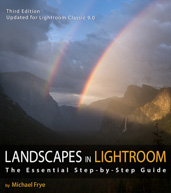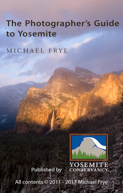In the Moment:
Michael Frye's Landscape Photography Blog
by Michael Frye | Oct 29, 2015 | Yosemite Photo Conditions
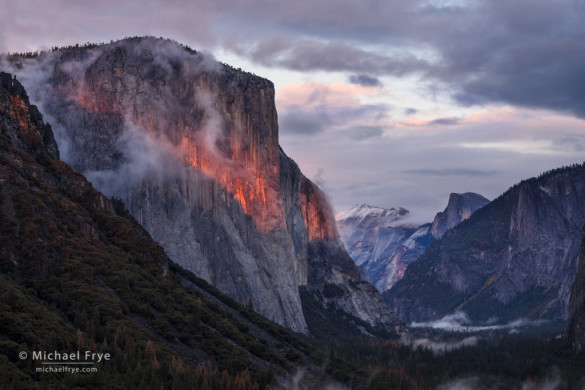
Sunset light, Tunnel View, yesterday evening
Some interesting weather passed through the Sierra Nevada yesterday. It so happened that I had an errand to run in Yosemite Valley, which gave me an excuse (as if I needed one) to go up there and check on the weather. After taking care of the errand, Claudia and I ended up at Tunnel View, where we waited out a thunderstorm. I tried to take a nap in the car, but was rudely awakened several times by loud claps of thunder. After the rain stopped I went out to the viewpoint and waited for the sun to break through, joined by a number of other photographers, including some friends and acquaintances. Tunnel View is, by virtue of its popularity, the social gathering place for photographers in Yosemite.
Finally, just before sunset, the sun did break through and light El Capitan (see the photograph above). It’s funny how all those photographers can suddenly become quiet as they concentrate on composition and camera settings.
(more…)
by Michael Frye | Oct 25, 2015 | Yosemite Photo Conditions
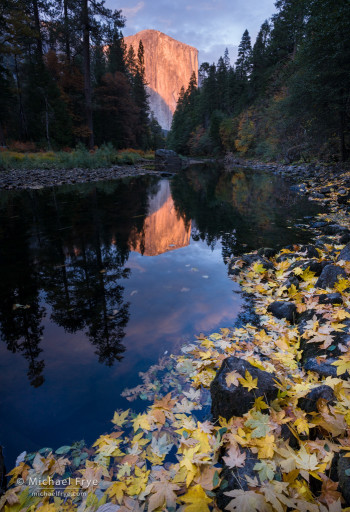
El Capitan and the Merced River, autumn, Yosemite Valley. This photograph from 2006 shows big-leaf maple leaves covering the foreground shoreline.
On my way home Thursday I drove the loop around Yosemite Valley to check on the fall color progression. The first thing that struck me was the cottonwoods, which have all dropped their leaves without turning yellow. Is this a sign of the drought? Maybe, but I saw the same thing happen in 2011, after one of the wettest winters and springs on record for Yosemite Valley. There are a lot of factors that affect fall color, so it’s hard to pinpoint one cause.
Some of the black oak leaves also seem to be turning brown. I’d say half of the oaks look fine (though still mostly green), and half appear to be wilting.
On the other hand, the big-leaf maples and dogwoods look pretty normal, though they’re turning late. Many maples sport a few brown leaves, but that’s actually pretty typical. The rest of the leaves are either healthy green or starting to turn yellow, and once they all turn yellow you won’t notice the brown leaves. Most of the dogwoods look quite normal overall, though they’re turning late.
(more…)
by Michael Frye | Oct 22, 2015 | Yosemite Photo Conditions
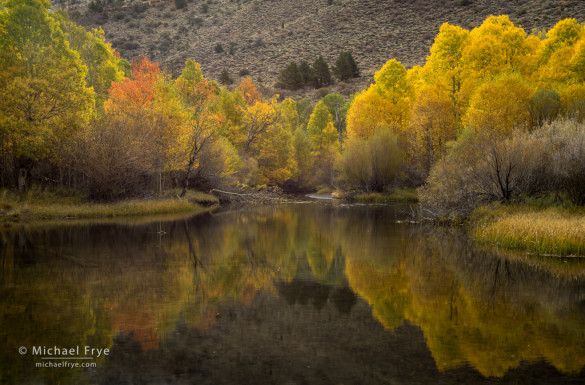
Aspens along a creek in the eastern Sierra Nevada, from last Friday
After nearly a month on the road in Colorado and the eastern Sierra, Claudia and I are heading home today. But before making the drive I thought I’d post a brief report about fall color on the east side.
Colder weather and wind this week have caused many leaves at higher elevations to drop off, yet there are some beautiful patches of color at lower elevations, along with many still-green aspens. Lower Lundy Canyon (up to the end of the dirt road) looks really nice right now, with about 70 percent of the trees turning, 20 percent green, and 10 percent bare. The June Lake Loop from Grant to Silver lakes has plenty of color, but is still only perhaps 50 percent yellow and orange, with 50 percent green. Lee Vining Canyon is maybe 60 or 70 percent green, with the rest either yellow, bare, or brown. Up a little higher, Conway Summit has some large bare patches, but a few groves there are still quite colorful.
(more…)
by Michael Frye | Oct 18, 2015 | Yosemite Photo Conditions
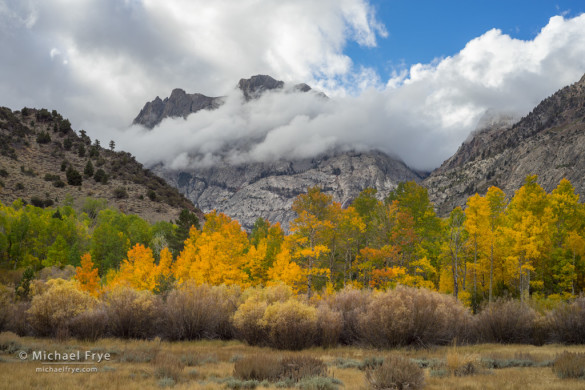
Peak and aspens during a clearing storm, June Lake Loop, Friday morning
The past week has been very warm, so there hasn’t been a big color change at the lower elevation aspen groves in the eastern Sierra during that time. But there’s definitely more color in those areas, and some great spots, although much of the June Lake Loop and Lee Vining Canyon are still green. Conway Summit, which is a little higher, has some very colorful groves, although it also has some bare trees, and green ones as well. Several spots in the greater Lee Vining area seem to have more oranges and reds than usual.
We also found some beautiful color in Bishop Creek Canyon. North Lake is past peak, though there was still some nice color along the shore. But lower down we found lots of colorful trees, especially along the road to South Lake.
(more…)
by Michael Frye | Oct 12, 2015 | Yosemite Photo Conditions
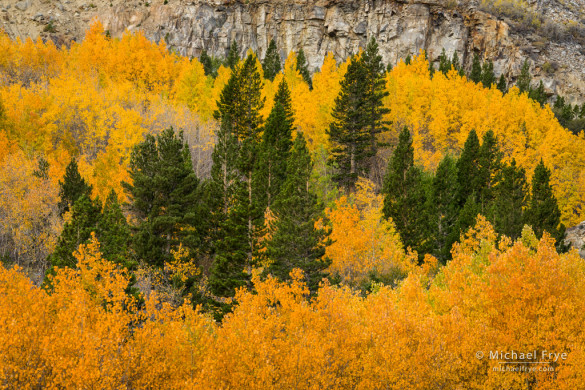
Aspens and lodgepole pines, upper Lee Vining Canyon, yesterday afternoon
After returning from Colorado, and spending a couple of days at home, Claudia and I are back in the eastern Sierra. Yesterday we scouted areas around Lee Vining, and most of the aspen groves here are at about the stage you would expect for the second week of October. That means that the lower-elevation aspens still have a lot of green, and more color can be found in the mid- and high-elevation areas. The best color we saw was in Warren Canyon (in upper Lee Vining Canyon), around Conway Summit (including the lowest part of the road to Virginia Lakes), and Dunderberg. The June Lake Loop and lower Lee Vining Canyon still show a lot of green. We didn’t visit Lundy Canyon yet, but heard there was some nice color there.
We also found some aspen groves that seem to have lost their leaves prematurely. These tend to be in drier areas, so that might a sign of the drought. But these places are a minority, and most of the aspens look healthy and are changing according to their normal schedule.
(more…)
by Michael Frye | Oct 7, 2015 | Announcements, Digital Darkroom
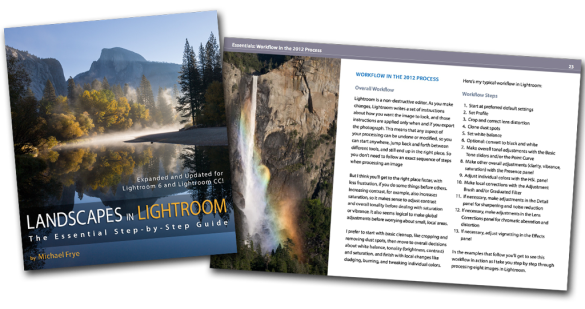
Landscapes in Lightroom: The Essential Step-by-Step Guide
PDF ebook with video tutorials
103 double-page spreads
14.95 for a limited time, after which it goes up to 27.00
FAQ


Here it is! The latest update to my ebook, Landscapes in Lightroom: The Essential Step-by-Step Guide, is now available. This new edition is revised and updated for Lightroom 6 and Lightroom CC, and includes two new examples and videos demonstrating how to use the most significant new features – the HDR Merge and the Panorama Merge.
Of course this new version still has all the features that made the first edition so popular. First, you can download the original Raw files used as examples in the ebook, and then follow along with each step yourself – just as if you were attending one of my workshops.
Second, when you purchase the ebook you get exclusive access to ten videos demonstrating different aspects of Lightroom’s Develop Module, like using the Adjustment Brush, Spot Removal Tool, and Point Curve, advanced retouching in Lightroom, the new HDR Merge, and much more. It’s great to read about a tool or technique; it’s even better to watch a demonstration, and then try it yourself on the same image.
And third, there’s the PDF ebook itself. This includes eight examples, where I take you step-by-step through processing each image in Lightroom. You’ll get to see my workflow in action, with a variety of images – high contrast, low contrast, color, black and white, HDR merge, and panorama. You’ll learn many specific techniques and tips, but perhaps more importantly, you’ll gain insight into the decision-making process that so many photographers struggle with. How much contrast is enough? How far can you push the saturation without making the image look garish or fake? What’s the right white balance?
(more…)
by Michael Frye | Oct 6, 2015 | Travels and Stories
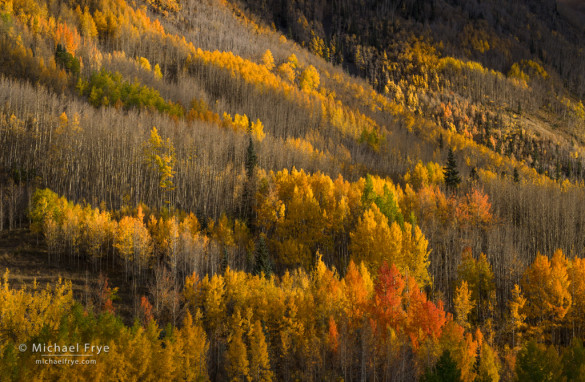
Aspens near Red Mountain Pass, Colorado, USA
We’ve had a wonderful time in Colorado – again. The color hasn’t been as good as last year, but all the locals said that was one of the best autumns they’ve seen. This year the color was shaping up nicely around the San Juan Mountains in the southwestern part of the state, but then last Friday strong winds blew the leaves off many of the aspen leaves. Some areas seem to have received especially strong winds, leaving either bare trees or green ones, and few yellow leaves. But other places weren’t affected much at all, so there were still large swaths of spectacular color.
Here’s a photo from last week near Red Mountain Pass, outside of Ouray. This was made before the wind storm, but this is a high-elevation, early-changing spot, so some of the leaves had already fallen. Sometimes, however, a mixture of colorful leaves and bare trees is more interesting than just a mass of color; in this case the bare patches helped to make the diagonal lines of color stand out and create a pattern.
(more…)
by Michael Frye | Sep 30, 2015 | Travels and Stories
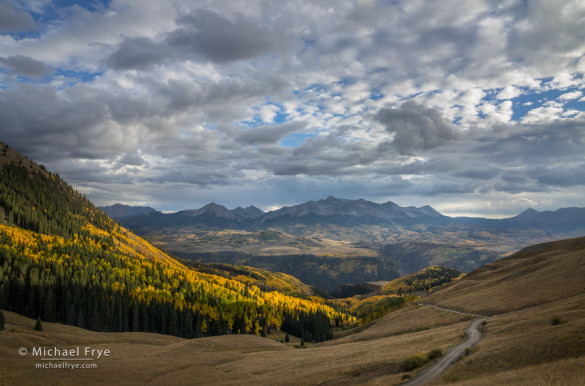
Autumn afternoon in the mountains near Telluride, Colorado, yesterday afternoon
I had planned to go to the Alabama Hills or Death Valley for last Sunday’s lunar eclipse, but high clouds streamed in from the Pacific and threatened to block the view. So at the last minute Claudia and I decided to go further south, toward clear skies that were visible on satellite photos. We ended up in Joshua Tree National Park – along with many, many other people who seemed to think this was a good place to view the eclipse.
They were right of course – it was a great place. And the skies cooperated for the most part. I captured a sequence that I think will work, but I haven’t had a chance to process it yet, because the next morning we started driving to Colorado. We loved our autumn visit last year, and just had to go back. Colorado welcomed us with some nice clouds on our first afternoon; I’ve included one image from that evening above.
(more…)
by Michael Frye | Sep 24, 2015 | Announcements
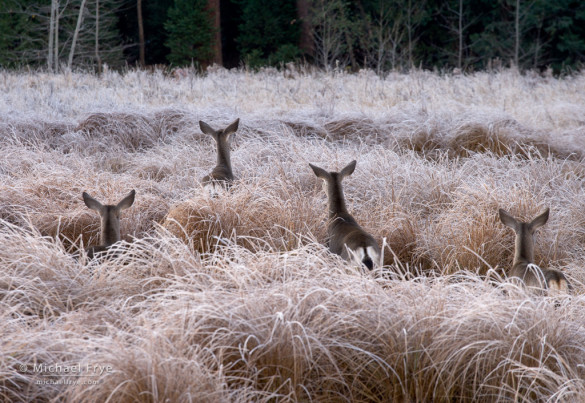
Curious deer, Yosemite NP, CA, USA
I just sent my prints to the G2 Gallery in Venice, California, for their upcoming exhibit, “Off the Beaten Path: Views From Yosemite.” This looks like a wonderful show, with photographs by Alan Ross, Robin Black, Art Wolfe, Franka Gabler, Ian Shive, Clyde Butcher, Marc Muench, and many others. They chose two of my Yosemite wildlife images for the exhibit, Curious Deer, and Coyote in Snow. The show runs from September 29th to November 15th. Unfortunately I won’t be able to make it to the reception on October 3rd, but I’m sure I’ll be missing a fun event. If you’re in southern California I hope you’ll have a chance to check out the show or attend the reception. You can find more information and see some photographs from the exhibit here.
— Michael Frye
(more…)
by Michael Frye | Sep 22, 2015 | Night Photography, Photography Tips
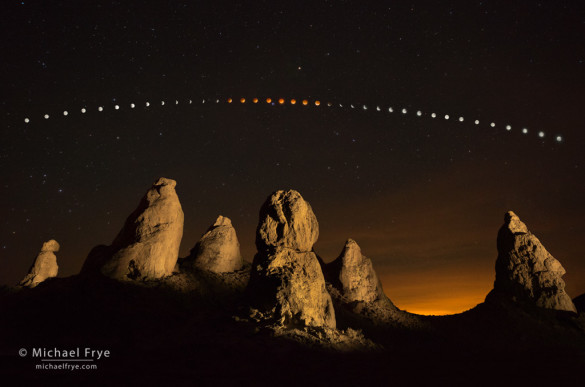
Lunar eclipse sequence, April 14th and 15th, 2014, Trona Pinnacles, CA, USA
We’re going to get another chance to photograph a lunar eclipse this Sunday evening in North America and South America (or early Monday morning in Europe and Africa).
This eclipse also coincides with the moon’s perigee, meaning that the moon will be at its closest point to the earth during its orbit, and will look bigger than usual. The media is going to make a big deal about this “supermoon,” but the moon will only look seven percent larger than average, a difference that won’t be readily apparent to the naked eye, much less in photographs.
However, every total lunar eclipse is special – a spectacular event to view and photograph. And unlike the last one in April, this one will feature a long total eclipse phase.
(more…)



















